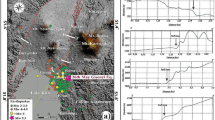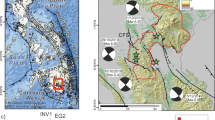Abstract
According to the requirement of the project “Establishment of the Physical Model of Earthquake Precursor Fields”, this paper elucidates the train of thinking for research on the project and some scientific problems which must be studied; the elucidation emphasizes that the core of this project is to study the conditions and processes of the generation of strong earthquakes. The paper first outlines the origin and development of the “strong-body earthquake-generating model” proposed by the author in the 1980’s; and then proves the reasonableness of the model from three aspects, namely: deep structures, mechanical analysis and rock fracture experiments. By studying the tomographic image for the northern part of North China, it can be seen that the sources of strong earthquakes are all distributed in high-velocity bodies, or in the contact zone between high-velocity and low-velocity bodies but nearer to the high-velocity body. It has been affirmed through studies of the mechanical models of hard and soft inclusions that the existence of a hard inclusion is an important condition for the high concentration of large amounts of strain energy. A lot of theoretical and experimental studies have been made to investigate the conditions for rock instability; the results have consistently indicated that rock instability, sudden fracture and stress drop would be possible only if the stiffness of the source body is greater than the environmental stiffness.
Similar content being viewed by others
References
Brady, B. T., 1975. Theory of earthquakesI: inclusion theory of crustal earthquakes.Pure Appl. Geophys.,113, 1/2, 149–168.
Chen, Y., Hao, J. S., Yan, W. L. and Liu, X. H., 1982. The effects of machine stiffness on the acoustic properties of marble sample under uniaxial compression. In:A Collection of Papers of ISCSEP, 660–668. Seismological Press, Beijing.
Dobrovolskii, I. P., 1991.Theory on the Preparation of Tectonic Earthquakes, 1–30. Izv. An USSR, Moscow (in Russian).
Feng, D. Y., Shu, L. D., Liu, X. L., Mei, S. R. and He, B. R., 1995. Research on the time-space evolution model of earthquake precursor fields in the northern part of North China: with the Tangshan earthquake as an example. In: Division of Science, Technology and Monitoring, State Seismological Bureau (ed.),Collected Works on Third-Order Subjects of the Key Problem Tackling Program for Short-Term/Imminent Earthquake Predictions under the 8th Five-Year Plan (in press). Seismological Press, Beijing (in Chinese).
Mei, S. R., 1970. A way of risky area zoning as viewed from the regularity of seismic activity in North China.Seismological Front: Special Issue on Academic Discussions, 1–11 (in Chinese).
Mei, S. R., 1982.Implications of the Tangshan Earthquake, Chap. 17, 429–447. Seismological Press, Beijing (in Chinese).
Mei, S. R., 1985. The regional nature of earthquake precursors.Earthquake Research in China,1, 17–22 (in Chinese).
Mei, S. R. and Liang, B. Y., 1989a. A mathematical simulation for seismogenic process of the Tangshan earthquake.Earthquake Research in China,5, 9–17 (in Chinese).
Mei, S. R., Liang, B. Y. and Zhu, Y. Q., 1989b. Digital simulation on precursory mechanism of the 1976 Tangshan earthquake.Earthquake Research in China,5, 27–34 (in Chinese).
Mei, S. R. and Zhao, Y. L., 1993. The relation between the three-dimensional velocity structure and seismic activity in the Bohai Sea and adjacent area. In:Selected Papers of Mei Shi-Rong on Seismological Science, 391–411. Seismological Press, Beijing (in Chinese).
Sadovskii, M. A. and Pisalenko, V. F., 1989. Discrete model of geophysical media.Comprehensive Studies by Physics of the Earth, 9–26. “Nauka” Moscow (in Russian).
Sun, R. M., Zhao, Y. L. and Mei, S. R., 1993. Seismic tomographic image of the Bohai Sea and adjacent area.Acta Geophysica Sinica,36, 44–54 (in Chinese).
Sun, R. M. and Liu, F. T., 1995. Crustal structure and earthquake occurrence in the Beijing-Tianjin-Tangshan area — structure of P-wave velocity.Acta Geophysica Sinica (to be published).
Zhang, L. Xiao, X. H., He, C. R., Zhao, S. Q. and Wang, Y. L., 1995. Nonlinear behaviors during the process of rock deformation-failure and their relation with system instability. In: Division of Science, Technology and Monitoring, State Seismological Bureau (ed.),Collected Works on Third-Order Subjects of the Key Problem Tackling Program of Short-Term/Imminent Earthquake Predictions under the 8th Five-Year Plan (in press). Seismological Press, Beijing (in Chinese).
Author information
Authors and Affiliations
Additional information
This subject is one of the “8th Five-Year Plan” of the SSB, China.
About this article
Cite this article
Mei, SR. On the physical model of earthquake precursor fields and the mechanism of precursors’ time-space distribution — origin and evidences of the strong body earthquake-generating model. Acta Seismologica Sinica 8, 337–349 (1995). https://doi.org/10.1007/BF02650562
Received:
Accepted:
Issue Date:
DOI: https://doi.org/10.1007/BF02650562




